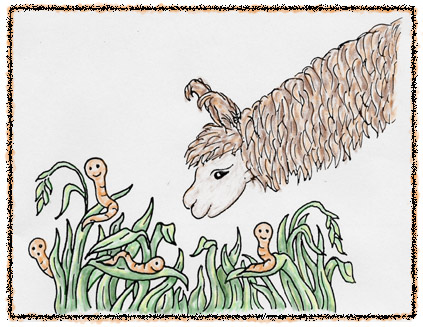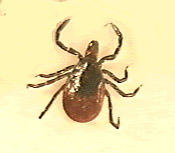Important
NEW Information About
Gastrointestinal Parasites in Camelids
Drug Resistant Worms -Gastrointestinal parasites are a leading cause of disease in all
grazing livestock, including camelids.
The blood-feeding nematode, Haemonchus contortus,
is especially devastating,
because it can
cause anemia
and death. Read this important
information about dewormer resistant
parasites.
The Haemonchus contortus (the barberpole worm).
What Is A Parasite?
A parasite
is an organism that grows, feeds, and is sheltered on or in another type of
organism while contributing nothing to the survival of its host.
In this instance, the host is our llamas although all other livestock
become the hosts for parasites too. There
are two classifications of parasites that affect our llamas.
The first one is Internal parasites – parasites that live and
feed inside the llama’s body. These
are most often different varieties of worms that live and multiply in the small
intestine or the stomach of the llama. The
second classification is External parasites – those that live and feed
off the outside of the llama’s body. Some
examples of external parasites are ticks, flies, mosquitoes, lice, and mites.
Effects of Internal Parasites .....
There are many types of internal parasites known that infect llamas and keeping
our llamas safe from these parasites is a year-round job for the llama owner.
If parasites are not controlled, the llama can become unhealthy and unthrifty.
A heavy load of
parasites can cause the llama to become sickly and lose weight since the worms
living in the llama steal a lot of the nutrition that is needed by the llama.
Internal parasites can be a severe problem to llamas sometimes even
causing death. Now that some worms are becoming resistant to the dewormers
on the market, today's llama owner must even be more informed about parasite
control and management.
Preventive Measures ………
- Herd Management
- Pasture Management
- Soil Management
Good herd management is the primary prevention of parasite problems.
A good nutritional program and awareness of the overall health of your
animals is the first basic, but very important, step.
Parasites are more likely to seek out and attack weak or failing animals.
Good sanitation, pasture rotation, and the weather also play a big part
in the control of parasites on your farm. The
weather can make a big difference in parasites on your farm. Many think the winter’s cold temperatures kill the parasites, but in
fact
the summer heat is more effective in killing eggs and larvae.
The Life Cycle Of Parasites ………
Without proper management, the internal parasites become a constant cycle.
The worms live inside the llama getting nutrition from the llama’s body.
When the worms are adult,
they lay eggs. The eggs get passed
out of the llama in their feces, or manure, and end up in the pasture.
Then the eggs either hatch into larva in the manure or on the ground. Rain then washes the manure off of the larva and the larva is
left to live on the blades of grass. Then
a llama may swallow the larva while grazing.
Once inside the nice environment of a warm llama, the eggs and larva will
mature into adults in about three weeks. These
adults now lay more eggs and the cycle starts all over again.
So if the llama owner does not practice good de-worming herd management,
the animals will
eventually have a very heavy load of adult parasites.
Carrying a heavy load of internal parasites also means a llama is getting
only partial value from his food.
What about the llamas that are wild in the mountains of South America and
don’t have owners to de-worm them? Why
don’t they get sickly from parasites? Llamas
that are out in the wild travel a large area while grazing and browsing.
So, since they are moving from area to area, most of the time they are in
new, clean grasses that do not contain eggs and larvae so they are not ingesting
eggs. Our llama herds here are
often in smaller confined areas and if there are too many llamas for the area
(over crowded pastures), then the chance of having parasites is much greater.
Common Internal Parasites That Affect
Llamas ………
The most common signs of internal parasites are generally diarrhea and weight
loss. The following are some of the most
common internal parasites that we encounter here in the Midwest area.
Trichuris
(whipworm) -
Whipworms in the Intestine.
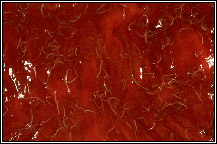 |
The eggs of this species may survive for
years.
Click Here
to enlarge photo. |
More commonly called
Whipworm, this worm lives in the large intestine of the llama. The eggs are passed in the feces and the larva develops inside of the
eggs. These eggs may survive for years. When eaten by the llama or
the host, the eggs hatch in the small intestine and then migrate into the large intestine
and develop into adults. The adults
then lay eggs to continue the life cycle.
Moniezia
- Commonly known as Tapeworm
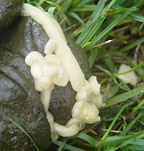
A long tapeworm passed in a soft stool.
|
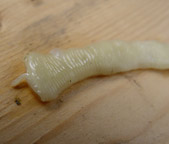
The head of a tapeworm. The adult is a long, white,
flat worm that is in segments.
Click Here
to view a larger image. |
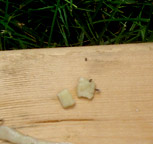
A small single segment of the tapeworm. This is what you
will normally see in the llama poop that looks like a grain or rice. |
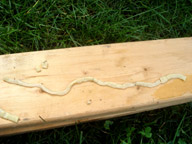
The flat tapeworm stretched out. This is not the complete worm as some segments
have come off.
Click Here
to view a larger image. |
The adult tapeworm is a white flat worm that is in segments. The tapeworm attaches to
the wall of the llama’s small intestine. Segments, or pieces of the tapeworm, which contain eggs, are passes into
the feces and may be seen in the llama’s manure.
They will look like small grains of rice. The eggs are then eaten by the oribatid mite, an intermediate
host. This mite lives on the grass or on the feces and contains the tapeworm
larvae. Now the mite is eaten by
the llama while eating pasture grasses. The
larvae attach to the llama’s intestinal wall, mature into adults, and continue
the life cycle.
Trichostrongylus (stomach worm) -
Among them is the
Haemonchus contortus, commonly called barberpole worm.
|
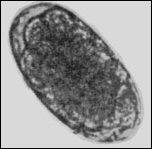
Strongyle Egg
|
These eggs develop rapidly, hatching in less than twenty hours in summer
temperatures (70 - 80 degrees F.) If the eggs dry out before they hatch they become dormant and can
survive for as long as 15 months. |
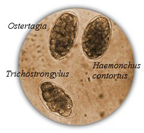
Three Most Common Types of Strongyle Eggs |
It is not often possible to identify strongyle eggs to genus level as the eggs of most strongylid and trichostrongylid species are similar in appearance and overlapping in size.
If identification is necessary the fecal sample must be cultured to provide L3 larvae for further examination. |
These are very small stomach worms that live in the
small intestine of the llama. The
eggs are passed in the feces. They
hatch and develop into larvae in the soil and in the feces. The llama may then eat these larvae from the soil or from
their feed or water. The larvae
grow to adulthood in the stomach and small intestine.
A few years ago, the description above of this parasite
family was sufficient. However, today the Haemonchus contortus
species has become common and drug resistant in many species of
livestock and is a severe problem and cause of many deaths. As
a livestock owner, you need to become familiar with this parasite,
its life cycle, and new methods of treatment.
Nematodirus (thread-necked strongyle)
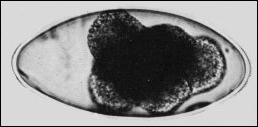 |
These eggs hatch very rapidly in wet weather.
Cool, wet weather and lush, moist pastures are ideal conditions for eggs
to live.
|
The eggs of this parasite are very large and are distinctive under the microscope.
They are very sturdy eggs and may even survive the winter in the feces or the soil.
The larvae develop inside of the egg and may survive for
several months in the soil or in vegetation.
The llama then eats the larvae on the pasture grasses which then mature
into adults in the llama’s small intestine.
Eimeria
(coccidia) - Coccidia are tiny one-celled organisms which multiply
in the intestinal tract of many animals.
The resulting disease, called coccidiosis, is most common in
young animals or animals that are stressed – possibly from moving to a new
farm. The disease is more common in the fall and winter months.
Coccidia are spread in the feces of an infected animal and most commonly
exists when animals are overcrowded into small areas or where unsanitary
conditions exist.
However an animal must ingest a large number of coccidia
organisms in order to get sick. If
an animal ingests only a small amount, he probably will not get sick and it will
produce immunity to this disease.
The main sign of coccidiosis is diarrhea. Depending on the level of infection, the diarrhea may become severe and
blood may be present. Then the animal becomes depressed, loses weight, becomes
dyhydrated, and may become very sick. Death
can occur. Corid is the most common
treatment for coccidiosis and can be given by mouth or in the drinking water.
Parelaphostrongylus (meningeal worm)
- Meningeal Worm is a great concern to llama owners
in areas in the east where white-tailed deer have a heavy population.
Although we have white-tailed deer in Indiana, luckily this doesn’t
seem to be a very large problem here. This
is a natural parasite which lives in, but does not affect, white-tailed deer. The worm is passed from an infected deer through its feces and then must
pass through another developmental stage in a snail or slug.
The disease CANNOT be passed without the ingestion of an infected snail
or slug. The llama then may
inadvertently ingest the snail when browsing and
become infected.
The worm migrates into the central nervous system causing neurological
abnormalities in the llama. Signs of Meningeal Worm include staggering, paralysis,
dragging of rear legs, and blindness. If
aggressive treatment is not begun immediately, death may
occur.
Controlling The Parasite Problem .........
As part of preventive health maintenance for llamas, owners de-worm them with
various medications on a proper deworming schedule. Controlling the number of eggs and infective larva that a
llama consumes is the starting point of any effective de-worming program.
The de-worming schedule is important as well as the type and dosage of
medication administered.
When de-worming, the entire herd should not routinely receive the medication.
Females that are within 60 days of birthing or within 60 days of breeding
should not receive deworming medications.
(Females in this stage should not receive any medications whatsoever.)
Only those animals that show signs of distress from parasites, have
a high fecal egg count, showing signs of anemia, or register in the
danger area of the Famacha chart, should receive deworming
medication. This is an entirely new and different approach
than what the veterinarians recommended a few years ago.
Certain varieties of worms have become resistant to the dewormers
due to past practices of routinely treating the entire herd.
When you do find it necessary to deworm certain animals, these
following practices can still be beneficial. Clean Pastures:
after approximately three days the pastures should be cleaned of the
manure on the ground to prevent the llamas from re-infecting
themselves with parasite eggs in the pasture. The eggs take 3-4 days
to mature so you have that length of time to remove manure from the
contaminated pastures. This will greatly decrease the chances of new
infections. Pasture rotation can also be beneficial.
However de-worming is not the most effective way to help control parasites. Managing your llama’s environment is one of the
very best strategies for
parasite control. Since the major
objective is preventing pastures from being contaminated with worm eggs, manure
removal from their barn areas and pastures will greatly help in breaking up the
parasite life cycles. When cleaning
pastures, although not all the manure may be able to be removed, the manure is
getting raked and broken up, so on hot, dry days, the sun dries out the eggs and
larvae and they die. Parasitic larva in manure in the sunlight dries out whereas
larva in manure in moist, damp, dark areas survive for months. Cool, wet weather and lush, moist pastures are ideal conditions for eggs
to live.
Hay racks, feed dishes, water buckets, and automatic waterers should be regularly
cleaned to prevent any possibility of parasites living there. Llamas should not be fed on the ground, as this would increase the
likelihood of llamas infecting themselves with parasites that may be living on
ground vegetation. To check how effective your parasite management program is
you can have your veterinarian check your llama’s feces for parasite eggs.
Or learn to do your own fecals. It is not hard to do and over
time, the equipment you purchase will pay for itself with less vet
fees.
What To Treat With ……….
Some
infective larva, such as Nematodirus and Trichurs, can even become dormant over
the winter and survive temperatures to 20 below zero.
Then they can become infective again about one month after
pastures begin new growth in April and May.
For this reason, only third generation wormers that are larvacidal are
recommended for treatment. Examples
are Ivermectin, Oxbendazole (Synanthic), and Albendazole (Valbazen).
A third generation wormer attacks the eggs, the larva, and the adults.
Panacur or Safeguard is only effective for adult worms and does not
affect the larva. Ivermectin or
Dectomax is mainly effective on Brown Stomach Worms and Meningeal Worm.
Both Valbazen and Synanthic address Nematodirus and Trichurs. Strongyles
normally will respond to Fenbendalzole (Panacue or Safeguard) or Ivermectin.
Recently many farms are experiencing problems with the deadly
barberpole worm as it has become resistant to most of the
medications. Many farms are successfully now using Quest (Moxidectin)
for this parasite, but with overuse, this worm is becoming resistant
to moxidectin too. Owners today should be familiar with the
Famacha system. Recent research has brought about entirely
new procedures for parasite control as explained in the following
two articles:
Information About Gastrointestinal Parasites in Camelids - Resistant to
Dewormers and
Slowing Dewormer Resistance
There has been much discussion about the
use of Diatomaceous Earth (DE) as an effective method of controlling parasites,
however there are no studies that have been able to support its use. DE is
the skeletal remains of single-cell algae and is said to kill intestional worms
by cutting them with its knife-sharp surfaces. Although DE may not be
effective in controlling parasites when fed to the animals, it may be somewhat
helpful when used on the poop piles or on the pasture by killing the larvae and
therefore reducing the level of pasture contamination. Read more about the
DE studies here.
There is no
single method that works well for all farms and all animals. Each farm has
a different set of pastures and weather. What worked last year may not
work this year. And animals themselves vary in their natural ability to
fight parasites or even in shedding eggs on to the pastures. Successful
parasite management is unique to each individual farm and probably will take
some research and a combination of methods of control.
~~~~~~~~~~~~~~~~~~~~~~~~~~~~~~~~~~~~~~~~~~~~~~~~~~~~~
Common External Parasites
The most common aggravation in the barnyard, flies, seem to go hand in hand with
raising animals. However there are
some effective methods of control. Although
primarily an annoyance, flies may cause problems such as eye irritations from
feeding on tears, painful bites, and carrying disease from one animal to
another. Manure removal is the most
effective aspect of fly control since so many flies need manure for their eggs. A fly repellant is most helpful on the legs of the llama.
Disposable fly traps, although quite smelly, can be hung around the area
and can be quite effective trapping adult flies. Thousands of adult flies can be trapped per trap - and that’s thousands
that do not lay eggs and multiply! Natural
predators can also be very beneficial in the reduction of flying critters such
as flies and mosquitoes. Barn
Swallows and Purple Martins both eat flying insects. It is claimed that Purple Martins eat as many as 2,000 mosquitoes a day.
A bat house may also attract bats to your property which are beneficial
in reducing flying insects at night.
Other
external parasites include mites, ticks, and lice. A mite, whose entire life cycle is spent on the animal,
burrows into the outer layer of tender skin areas with thin hair coats such as
the face, belly, chest, and legs causing Sarcoptic Mange. The area develops hairless spots, dandruff, scabs, and
becomes crusty. It may or may not
itch. As it develops, the skin
becomes thick, crusty, and leather-like. Ivermectin
injections are used as treatment as well as an external dousing of the area with
a parasite control.
Two types of lice may infest llamas - the biting
lice and the sucking lice.
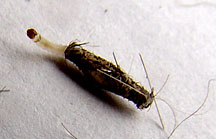 |
A lice with its neck extended.
Click Here
for larger image. |
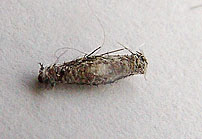 |
Lice with neck pulled in.
Click Here
for larger image. |
The
sucking lice feed entirely on blood and can cause anemia and spread disease. They prefer the head, neck and withers area where they actually imbed in
the skin. Treatment is Ivomec
injected 1cc/110 lbs. Biting lice nibble on hair and debris on the skin surface and
can be seen with the naked eye when disrupted. They are found most often by the base of the tail or the side of the
neck. Biting lice may be treated
with Coral dust (also used to dust rose bushes) by parting the wool down the
center of the back and pouring on the dust - about 3 Tbl. per adult llama or 1
Tbl./100 lbs. One method of
applying the dust is to put the dosage into a mustard bottle and squeeze it out
own
the spine. Sevin, also a dust, is
also used in the treatment of lice. If
lice is diagnosed in the herd, it could be treated by putting the Seven in the
llama’s dust bowls. The llamas
enjoy rolling in it and dust themselves.
Ticks
can also infest llamas, but the tick type is dependent upon the geographical
area. The Rocky Mountain wood tick
causing tick paralysis is not found in this Midwest area. Ticks attach to their host and feed on the blood.
Remove a tick carefully and perhaps treat the bite with hydrogen
peroxide.
|
